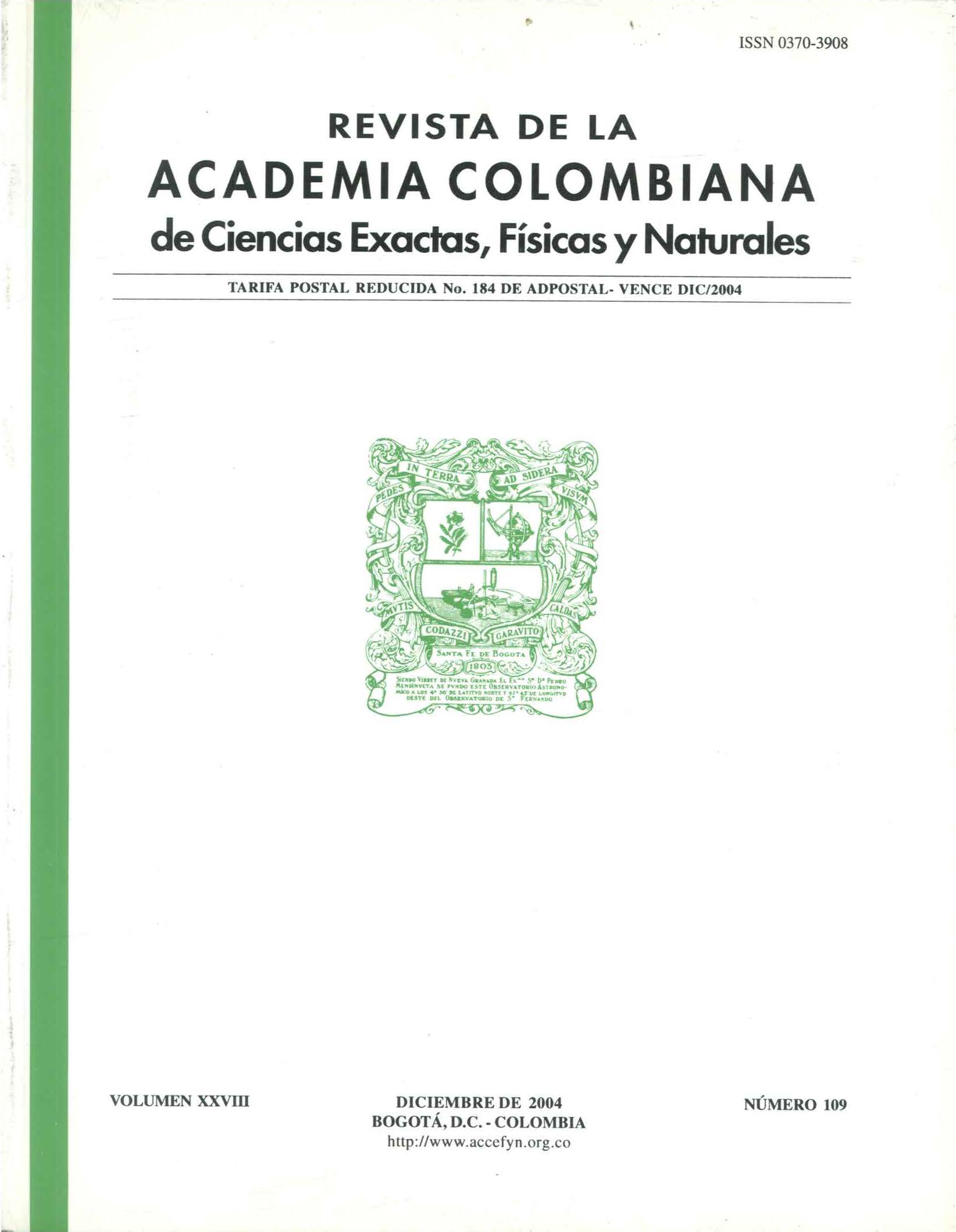Resumen
Con el fin de analizar el fenómeno de la adsorción física de un péptido sobre hidróxido de aluminio, se sintetizaron dos series de análogos de una secuencia de 20 aminoácidos proveniente del fragmento de 42 kD de la proteína MSP-1 de Plasmodium falciparum, sustituyendo cada una de las posiciones por ácido aspártico o por lisina. Los resultados de estas modificaciones no mostraron una tendencia regular en la solubilidad o en la adsorción de los análogos. En la serie de ácido aspártico, el péptido de mayor adsorción es el correspondiente a la sustitución de la posición 6 y el de menor a la posición 5; sin embargo, no se observaron diferencias estructurales significativas entre estos dos análogos. La disminución de la adsorción de los análogos de la serie de lisina respecto a la secuencia original, indica que este fenómeno es dirigido principalmente por efectos electrostáticos.
Referencias
Al-Shakhshir, R. H., Regnier, F. E., White, J. L., & S. L. Hem. 1994. Contribution of electrostatic and hydrophobic interactions to the adsorption of proteins by aluminium-containing adjuvants. Vaccine 12: 472-474.
Al-Shakhshir, R. H., Lee, A. L., White, J. L., & S. L. Hem. 1995, Interaction in model vaccines composed of mixtures of aluminium-containing adjuvants. J. Colloid Interface Sci. 169: 197-199
Al-Shakhshir, R. H., Regnier, F. E., White, J. L., & S. L. Hem. 1995b. Contribution of electrostatic and hydrofobic interactions to the adsorption of proteins by aluminum-containing adjuvants. Vaccine 13: 41-44.
Blackman, M. J. & A. A. Holder. 1992. Secondary processing of the Plasmodium falciparum merozoite surface protein by a calcium-dependent membrane-bound serine protease shedding of MSP as a noncovalently associated complex with other fragments of the MSP-1. Molec. And. Biochem. Parasitol., 49: 29-34
Brown, R. E., Jarvis, K. L. & K. J. Hyland, K. 1989. Protein measurement using Bicinchoninic acid: Elimination of interfering substances. Anal. Biochem. 180: 136-139
Callahan, P. M., Shorter, A. L, &. S. L. Hem. 1991. The importance of surface charge characteristics of aluminum-containing adjuvants. Vaccine 12:472-474.
Chang, M., White, J. L., Nail S. L. & S. L. Hem. 1997. Role of the electrostatic attractive force in the adsorption of proteins by aluminium hydroxide adjuvant. PDA J. Pharm. Sci. & Tech. 51(1): 25-29
Espejo, B. F., Cubillos, M., Salazar, L. M., Guzmán, F., Urquiza, M., Ocampo, M., Silva, Y., Rodríguez, R., Lyoi, E. & M. E. Patarroyo. 2001. Structure, Immugenicity, and Protectivity relationship for the 1585 malarial peptide and its substitution analogues. Angew. Chem. Int. Ed. 40: 4654-4657
Hem, S. L. & J. L. White. 1984. Characterization of aluminium hydroxide for use as an adjuvant in parenteral vaccines. J. Parenteral Sc. And Tech. 38(1): 1-10.
Hem, S. L. &. J. L. White. En: Powell M.F, Newman M.J., and Burdman J.R. editors. 1995. Vaccine design-the subunit and adjuvant approach. New York: Plenum Press, 249-75.
Houghten, R. 1985. General method for the rapid solid-phase synthesis of large number of peptides: specificity of antigen-antibody interaction at the level of individual amino acids. Proc. Natl. Acad. Sci., 82: 5131-5.
Martin, A., Swarbrick, J. & A. Camarata. 1983. A Physical Pharmacy, 3 rd edition, Lea & Febiger (Eds.), Philadelphia. Matheis, W., Zott, A. & M. Schwanig. 2002. The role of the adsorption process for production and control combined adsorbed bacines. Vaccine 20: 67-73.
Merrifield, R. B. 1963. Solid phase peptide synthesis I. The synthesis of a tetrapeptide. J. Am.Chem. Soc. 85: 2149-2154.
Rinella, J. V.jr., White, J. L., & S. L. Hem. 1995. Effect of anions on model aluminium adjuvant containing vaccines. J. Colloid Interface Sci. 172:121-130.
Seeber, S. J., White, J. L., & S. L. Hem. 1991a. Solubilization of aluminum-containing adjuvants by constituents of interstitial fluid. J. Parenteral Sci. Tech. 45: 156-159
Seeber, S. J., White, J. L., & S. L. Hem. 1991b. Predicting the adsorption of proteins by aluminum-containing adjuvants. Vaccine 9: 201-203.
Serna, C. J., White, J. L. & S. L. Hem. 1977. Anion-aluminium hydroxide gel interactions. Soil Sci. Soc. Am. J. 41: 1009-1013.
Serna, C. J., White, J. L., & S. L. Hem. 1978, Factors affecting homogeneous precipitation of aluminium hydroxide gel. J. Pharm. Sci. 67(8):1179-1181.
Shirodkar, S., Hutchinson, R. L., Perry, D. L., White, J. L., & S. L. Hem. 1990. Aluminum compounds used as adjuvants in vaccines, Pharm. Res. 2:1282-1288.
Smith, P. K., Krohn, R., Hermanson, A., Mallia, K., Gartner, F., Provenzano, M., Fujimoto, E., Goeke, N., Olson, B., & D. Klenk. 1985, Measurement of protein using Bicinchoninic acid. Anal. Biochem. 150: 76-85
Wiechelman, K., Braun, R. & J. Fitzpatrick. 1988. Investigation of the Bicinchoninic acid protein assay: identification of the groups responsible for color formation. Anal. Biochem. 175: 231-237.
World Health Organization (W.H.O.). 1976. Immunological adjuvants. World Health Organization Technical Report Series No. 595. Geneva: WHO, pp.6-8.

Esta obra está bajo una licencia internacional Creative Commons Atribución-NoComercial-SinDerivadas 4.0.
Derechos de autor 2023 Revista de la Academia Colombiana de Ciencias Exactas, Físicas y Naturales

